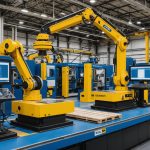Revolutionizing Home Building: How 3D Printing is Redefining Custom Housing Construction
The Dawn of a New Era in Construction
The construction industry, long known for its traditional methods and materials, is on the cusp of a revolution thanks to the advent of 3D printing technology. This innovative approach is not only transforming the way homes are built but also offering unprecedented design flexibility, cost savings, and environmental benefits.
Understanding 3D Printing in Construction
3D printing, or additive manufacturing, involves layering materials to create a structure from a digital design. In the context of home building, this technology uses a variety of materials, including concrete, steel, and even recycled wood composites.
In parallel : Revolutionizing uk manufacturing: how digital twins enhance operational excellence
Materials and Their Potential
One of the most significant advantages of 3D printing in construction is the versatility of materials that can be used. Here are some key materials and their potential:
-
Concrete: Widely used in 3D printing for its strength and durability. It can be mixed with various additives to enhance its properties.
Additional reading : Transforming early disease detection: how graphene-enhanced sensors are leading the charge
-
Example: NASA’s 3D-Printed Habitat Challenge saw teams using concrete to build structural components for habitats intended for deep space exploration[2].
-
Steel: Used for its high strength-to-weight ratio, making it ideal for structural elements.
-
Example: Some companies are using steel to print entire house frames, reducing the need for traditional framing methods.
-
Recycled Wood Composites: A blend of recycled sawdust and bioplastics, offering a sustainable alternative to traditional wood.
-
Example: Kei Atsumi’s “The Warp” pavilion at Dubai Design Week used a wood composite made from 30% recycled sawdust and 70% bioplastic, highlighting the potential for sustainable construction[1].
Design Flexibility and Complexity
3D printing allows for designs that would be impossible or highly impractical with traditional construction methods. Here’s how this technology is pushing the boundaries of architectural design:
Case Study: The Warp Pavilion
Kei Atsumi’s “The Warp” pavilion is a prime example of how 3D printing can merge traditional craftsmanship with modern technology. This structure, composed of over 900 unique curved wood panels, was made possible through computational design and 3D printing.
-
Computational Design: Atsumi noted, “This complexity is only possible with computational design.” The pavilion’s intricate design, which echoes Arabian sand dunes, was achieved through advanced modeling techniques[1].
-
Traditional Joinery: The pavilion’s components were assembled using a Japanese joinery system, allowing for easy assembly, disassembly, and relocation without the use of glue, nails, or metal fittings[1].
Cost Savings and Efficiency
One of the most compelling aspects of 3D printing in construction is its potential for cost savings and increased efficiency.
Comparative Analysis: Traditional vs. 3D Printing Construction
| Aspect | Traditional Construction | 3D Printing Construction |
|---|---|---|
| Material Usage | High waste generation | Minimal waste, uses recycled materials |
| Labor Costs | High labor costs due to manual labor | Reduced labor costs with automated processes |
| Construction Time | Longer construction time | Faster construction time, often weeks instead of months |
| Design Complexity | Limited design flexibility | High design flexibility, complex designs possible |
| Environmental Impact | Higher environmental impact | Lower environmental impact, sustainable materials |
Real-World Examples
-
NASA’s 3D-Printed Habitat Challenge: This competition demonstrated how 3D printing can reduce construction time and costs. Teams were able to autonomously 3D-print elements of habitats, showcasing the efficiency of this method[2].
-
Commercial Projects: Companies are now using 3D printing to build entire houses in a fraction of the time and cost of traditional methods. For instance, a company might print a house in under a week, compared to the several months required for traditional construction.
Environmental Benefits
The environmental impact of construction is a significant concern, and 3D printing offers several advantages in this regard.
Sustainable Materials
-
Recycled Materials: The use of recycled materials, such as recycled sawdust and bioplastics, reduces waste and the demand on natural resources.
-
Example: “The Warp” pavilion’s use of a wood composite made from recycled materials highlights the potential for sustainable construction[1].
-
Reduced Waste: Traditional construction methods result in significant waste, often up to 50% of the material used. 3D printing minimizes this waste by using precise amounts of material.
-
Example: Kei Atsumi noted, “Typically, when using wood for architecture, furniture, or other products, only around 50% of the material is used — the rest is waste. Here, we’re utilizing that waste, turning it into something sustainable and beautiful”[1].
The Future of the Construction Industry
As 3D printing technology continues to evolve, it is likely to have a profound impact on the construction industry.
Market Trends and Adoption
-
Increasing Adoption: More companies and governments are investing in 3D printing technology for construction projects. This trend is expected to continue as the technology becomes more accessible and affordable.
-
Example: The real estate market is seeing a rise in printed homes, with several companies offering 3D-printed housing solutions that are both cost-effective and sustainable.
-
Regulatory Support: Governments are beginning to recognize the potential of 3D printing in construction and are implementing regulations to support its adoption.
-
Example: Some cities are revising building codes to accommodate 3D-printed structures, paving the way for larger-scale adoption.
Practical Insights and Actionable Advice
For those interested in exploring 3D printing in construction, here are some practical insights and actionable advice:
Getting Started
-
Research and Education: Understand the different types of 3D printing technologies and materials available. Educational resources and workshops can provide valuable insights.
-
Example: NASA’s 3D-Printed Habitat Challenge provided a comprehensive framework for understanding the challenges and opportunities in 3D printing for construction[2].
-
Collaboration: Collaborate with experts in the field, including architects, engineers, and material scientists.
-
Example: Kei Atsumi’s collaboration with Mitsubishi Jisho Design and other experts resulted in the innovative “The Warp” pavilion[1].
Overcoming Challenges
-
Scalability: One of the main challenges is scaling up 3D printing technology for large-scale construction projects.
-
Example: Companies are working on developing larger 3D printers capable of handling large-scale construction projects.
-
Regulatory Compliance: Ensuring that 3D-printed structures comply with local building codes and regulations is crucial.
-
Example: Working closely with local authorities and regulatory bodies can help navigate these challenges.
3D printing is revolutionizing the construction industry by offering unprecedented design flexibility, cost savings, and environmental benefits. As this technology continues to evolve, it is poised to transform the way we build homes and other structures, making construction more efficient, sustainable, and innovative.
In the words of Kei Atsumi, “This complexity is only possible with computational design.” This statement encapsulates the potential of 3D printing in construction, where traditional craftsmanship meets modern technology to create something truly remarkable[1].
As we move forward, it is clear that 3D printing will play a significant role in shaping the future of the construction industry, offering a new language of architectural expression and sustainable building practices. Whether you are an architect, a builder, or simply someone interested in the future of housing, 3D printing is definitely worth keeping an eye on.











